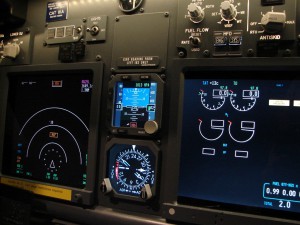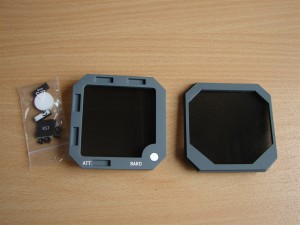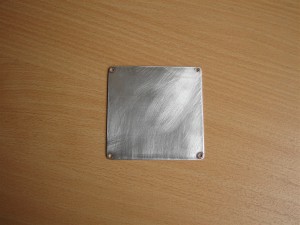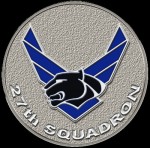Standby Instruments
DESCRIPTION
The standby instruments serve as a backup in case of a defect or for a X-check of the PFD and ND (DU's).
In the MIP of the B737-800 there are three (or two) standby instruments.
Three instruments for the analog version and 2 instruments for the digital version. The first Stby instrument is then covered with a picture.
The newer B737-800 (NG) are more and more equipped with a digital version.
The standby instruments are located between the Upper Eicas and the DU’s of the Capt.
ANALOGUE OR DIGITAL ?
As already mentioned, we have 2 options available for the MIP to provide standby instruments : make a choice between a analog or a digital version.
Despite the wide range of hardware at various handware-suppliers, I would have a preference for the instruments of
Flight Illusion. The main reasons are that the vents in my FlyEngravity-MIP are provided for the FI gauges. Also mainly because it is nicely finished instruments, and also due to the favourable purchasing conditions.
Analog standby instr Flight Illusion – old version
The ‘old’ version stby instr of FI is composed of a blue/black attitude indicator, an altitude gauge with a digital display and a 450 kts IAS gauge with or without the ‘barberpole’.
I have some research done but the last 2 gauges in a FI-version are nowhere to be found in a real B737-800 .... ? So not the right choice.
Analog Standby Instr Flight Illusion – new version
The new stby instr of FI have a thorough change :
The attitude indicator is now more spherical instead of plane, the altitude gauge is now a combi-gauge IAS and Altitude as in the real B737 aircraft. The speedometer needle is replaced by a RMI gauge.
These three analog gauges are very realistich and beautiful detailed finish.
Only the price tag for the three stby instruments is outside my budget (+-1200 €).
Digital gauge(s)
The question can be asked if I want my cockpit, maybe it can equip with digital stby gauges such as those found in the current B737-800's ? In a digital implementation, the opening of the top – the Attitude indicator – closed with a picture.
Below is a display with the ISFD (Integrated Standby Flight Display) or the ISIS (Intergrated Standby Instrument System). This is a mini-version of the PFD which speed, altitude, air pressure can be read.
The second standby instr below is a standard RMI. This can possibly also be replaced by a digital version to use (Prosim RMI Display module). This expresses the price also for a very large piece.
Digital gauges to use, there are a number of questions to the front with extra work :
- The current bezels on the MIP need to be replaced. Where can I get the correct bezels + parts ?
- Fit these bezels with the current openings in the MIP ?
- Fit these bezels with the TFT LCD display screens behind the MIP is placed ?
- To what should be the size this TFT LCD display screens to meet to behind the vents with bezels to be placed ?
- Where can I get this TFT LCD Displays to buy ?
- There Is behind the MIP enough space for 2 of these displays to place, both in width and in length ?
- Can I have 2 displays, one above the other without the edges of the screens are visible behind the bezels ?
- How do I get the TFT LCD Displays with A/D Board (controller card) to confirm against the back of the MIP ?
- There are still plenty of VGA connections on the different cockpitcomputers ?
- Are the displays rotated ?
- What is the price of everything ?
CONCLUSION
Despite these many questions and problems I have all the questions, a positive answer was found and I have also chosen to use the MIP to equip with 2 digital standby instruments, i.e. the ISFD and the RMI.
It's mainly the price that makes a difference. A complete price tag for this digital version is +- 280 €. A big difference with the analog version (1200 €).
Another reason for digital is that more and more real B737-800's are equipped with a digital version.
Hereby I must mention that I knoppeninterface on the bezels not have left, since I still rarely will use. Except, of course, if one has the necessary ‘failures’ are going to simulate, and that is not yet intended.
Also a reason is that the mounting of the various switches (tactical switches) in the bezels too delicate.
COMPOSITION
What hardware are these standby instruments are composed of :
- ISFD bezel with blank buttons
The ISFD-bezel I purchased at Sismo Soluciones. The dimensions around the bezel to cover the opening in the MIP and the inner dimensions of the bezelopening correspond to the available displayoppervlakte of the TFT LCD screen;
- RMI bezel
This bezel have k also purchased Sismo Soluciones. With this bezel, the inner and outer dimensions correspond to the MIP openings, and also with the available displayoppervlakte of the TFT LCD screen. Both bezels feature donkergetint plexiglass;
- Twoe RMI knoppen
The RMI buttons, I have met with ACV from Peru. Cheap, but nicely finished. Only the high transport costs you have to be there. You can buttons order to press a switch (encoder) or as a dummy. In this implementation, they serve only as dummy;
- Two TFT LCD display screens of 5 inches (5”).
These screens cover the openings in the MIP and the openings of the bezels.
These TFT LCD displays are composed of the screen, the A/D Board (PCBA controller card, button board for the adjustment and connections for VGA, video input and DC power input 12V. The resolution is normally 640×480.
This 5” display screens I purchased at the Chinese firm Good Display. The screens are of good quality and the service of the company is excellent (Thanks to Ariel, Ma). The delivery is unbelievably fast ...;
- Afdekplaatje
This cover plate serves to make the opening for the top is not used, stby instr (analog attitude gauge cover.
The dimensions of this image correspond to the 4 holes that are already to be found in the MIP;
- Sticker or decal
This sticker with text on the bottom of the cover. This decal (placard) I like all of the other MIP-decals engraving;
- Two VGA extension cables
These serve to make the connections between the TFT-VGA connector and the VGA connector on the pc.
ASSEMBLY
Bezels
- With the purchase of my FlyEngravity-MIP was this, with all 3 bezels around the openings of the standby instruments.
That must first be removed because these bezels do not match with the (real) ISFD - and RMI-bezel. - With double-sided tape are the 3 FlyEngravity - bezels on the MIP confirmed. They are quite easy to remove by using a small putty knife between the MIP and the bezel to cross. Once that one is in between sits the rest of the bezel release by itself.
Here one must be careful to bezel and MIP are not damaged. - Then I have the holes in the MIP adapted to the openings of the new bezels. The holes in the MIP were around and the new bezelopeningen are square. So I have small pieces should be looked from the alu MIP-plate to all the visible parts behind the bezels. I have just what you need removed so I may the old bezels still can use with these bezels and openings around still can cover or seal.
- The new bezels I have also on the back with double-sided tape.
It is the art of the bezels in the right place at the MIP paste so that the openings of the MIP are fully covered. And also, it should be horizontal... - The ISFD-bezel is already equipped with ‘dummy buttons’. That are simply in the openings glued.
- The RMI-bezel I have provided 2 RMI-buttons. One of them with a thin arrow and one with a thick arrow. These buttons are dummies and are just with double-sided tape on the bezel confirmed.
TFT LCD display screens
- To the TFT LCD displayschermpjes to places they need to be tilted . In the width there is not enough space and on their side there is on the backside of the MIP just enough room. On both sides there is a thick cm.
- First time I have been in the bottom plate of the MIP, a narrow opening cut to the lower LCD screen (RMI) in them to begin. Otherwise this screen looks a piece in the bezel-opening of the ISFD. And that is not the intention. Since the bezelkaders fairly thick, there is some slack and the 2 display screens nicely against each other without the edges of the display screens are visible in the two bezels.
- It is recommended that the A/D Board (PCBA controller card) to connect to the screen with the flat brown-coloured strip.
First on the AD/ Board the sluitpinnetjes of the bevestingsblok be released by a reverse pulling. Then the brown flat sockets in the white mounting block inserted, after which the vergrendelingspinnetjes back in closed position to be pushed.
Attention ! The brown flat strip must be on the correct side in the bevestigingsblokje be pushed (see pictures) !
ATTENTION ! THE BROWN FLAT STRIP OF THE SCREEN IS VERY SENSITIVE AND CAN IN A ROUGH MOVEMENT CAN EASILY BE DAMAGED OR TEAR !
THESE MUST THEREFORE BE TREATED WITH APPROPRIATE CARE.
- Then, the A/D Board to the back of the lens rotated it with double-sided tape is attached on the rear of the screen.
- To the TFT LCD display screens and to confirm at the rear of the MIP to be on the edges, at the front of the screens, double-sided tape applied.
The TFT LCD display screens at the rear of the MIP printed.
In the beginning, this happens slightly so that they subsequently move to the correct position : the edges of the screens may not see on the front of the MIP (bezelopeningen), the display surface of the screen should be the full opening of the bezel cover and they must be perfectly straight and horizontal.
Afterwards, the screens carefully and definitively against the MIP press.
AANSLUITEN
- First, all cables are connected. That of the power supply (12V) and the VGA connector.
With the power cable, I have the connector cut off and the wire, I just extended in the direction of terminal block from an external pc-power supply (12V). - The VGA cable goes to a free VGA port on one of the cockpit pc. In the absence of VGA port, one can also make use of a USB VGA Display Adapter.
This USB Display Adapter, which is basically an external video card which you have on one side a VGA connector and on the other side a USB connector in a free USB port of the computer.
With this adapter, there is also a manual and a CD with the necessary driver.
After installation of the driver can be a monitor via USB and use it in 4 modes : Extended, Mirror, Primary, and Display Rotation.
You can in Windows by the way 4 to 6 of these adapters to connect. You may not expect, but it works fine. This adapter(s) I have purchased from Conrad.be (J5Create.comand they are available in 3 sizes : VGA, DVI, and HDMI.
CONFIGURATIE
- The configuration of the TFT LCD display screens is done in 3 parts : first in Windows, then the TFT LCD itself, and then in ProSim737.
- When the connectors with the VGA are performed and after a reboot in Windows the 2 newcomers already see (display screen).
- A first problem is that the screen is usually on the wrong place state. It is sufficient the screen in Windows to shift to his current physical position.
(here we go, no computer classes, this would be known matter).
With the use of multiple screens, it is sometimes difficult to distinguish which screen we have to do. By making use of the ‘Identify’ or ‘Identify’ (in ‘View of your monitors to change’) to get back on the right track.
In fact, the resolution of these small TFT LCD Dispays is 640×480.
A second problem is when the windows-display image on the TFT LCD screen not visible (e.g. blue screen) and the reason may be, on the one hand that the screen is not the correct source has been found. It is sufficient to press the ‘Source button’ on the included TFT LCD control panel.
On the other hand, it can also be a to high set image resolution in Windows. This will need to be brought down to 640×480. - A third problem is that the image is tilted and on his side. We have the screens also on their side, just behind the MIP posted...
In Windows one can the image tilt in the right direction. There is also free software such as iRotate.
With the use of a USB Display Adapter, the image also rotate by its own software after installation of the adapter driver. - When the screen is in place and the screen itself is correctly adjusted, the rest of us, only the digital standby instrument in the screen. This is done through a Prosim Display Module.
Per standby instrument is there a separate Prosim Display Module launched. In the configuration of the module of Prosim is chosen which instrument it should be.
In windowmode is the scaled-down image window with the mouse is moved to the TFT LCD screen. Then, the size of the image adjusted to the size of the TFT display surface.
Through the config of the Prosim Display Module, one can still find the windowranden disappear, and can not in fullscreen-mode transition (for more info regarding the config of the Prosim Display Module, I refer to the Prosim manual).Whenever the Prosim Display Module to boot the standby instrument beautiful at the same location will appear.
Translated by Yandex.Translate and Global Translator




































